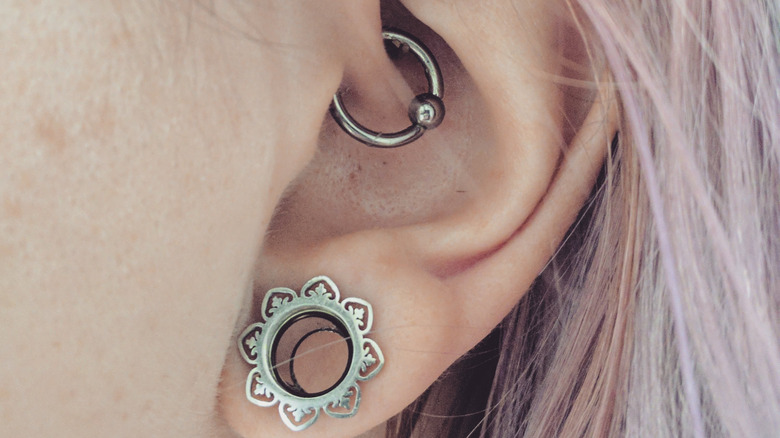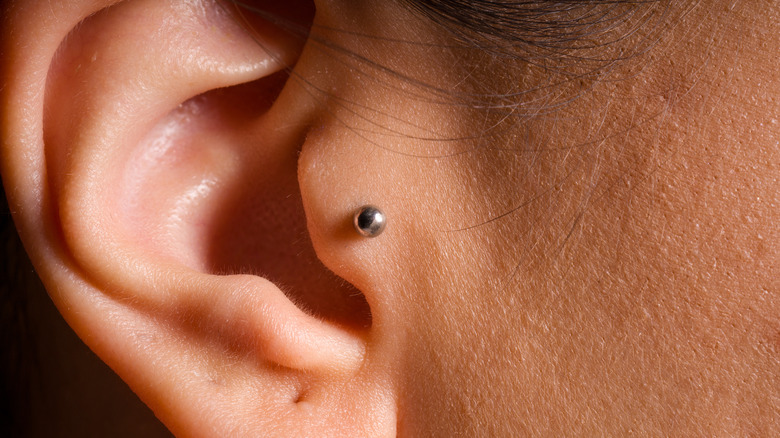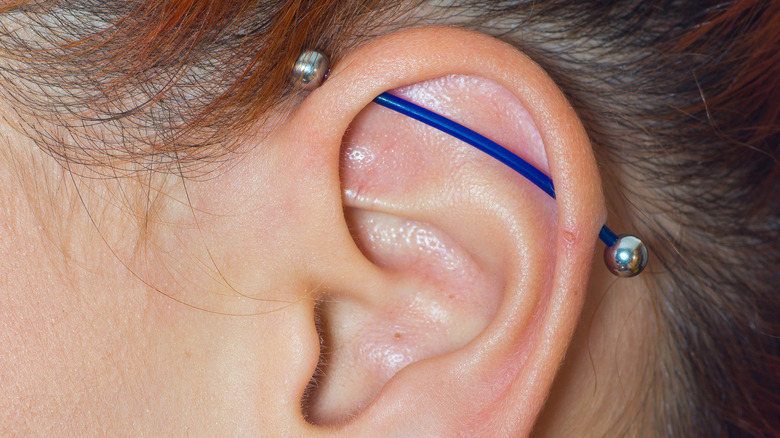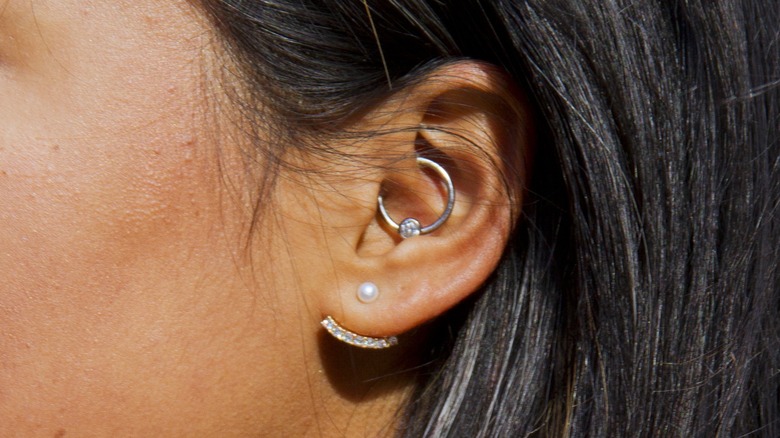
For a lot of us, ear piercings are our first experiences with body modifications. While tattoos and more unconventional piercings can come later, many of us first got our ears pierced as a tween or teen, or sometimes even younger. But, there are so many different ear piercings out there — not just the earlobe studs you got in grade school.
Of course, some people rock earlobe piercings, but there are plenty of other types all over your ear — why not explore them? From tragus and daith piercings to rook, conch, industrial, and even more, the possibilities are almost endless. If you don’t feel like getting a piercing somewhere on your body, but you’d still rather branch out a little, ear piercings are ideal! Maybe you’ve already decided that you’d like one, but you’re not sure what to go for. That’s why we’re here — just keep reading to find out about all of the ear piercings you can get!
Keep it traditional with earlobe piercings

Where better to start than with the classic earlobe piercing? These are often cheaper than other piercings and don’t usually hurt too much either, particularly compared to other piercings. If you’ve already got your earlobes pierced, you could always get second (or even third) piercings — there’s no rule that says you only have to have one in each lobe.
For something different, there are transverse lobe piercings (via Cosmopolitan). Instead of regular lobe piercings, in which the needle goes from front to back, these piercings go through the skin horizontally, and a barbell is used so that you can see both sides of the piercing. While the transverse lobe piercing is a little more uncommon than the standard lobe piercing, it’s similar along the pain scale and is a great alternative option (via Byrdie). You might associate earlobe piercings with getting the piercing gun as a child, but there’s certainly more to them than meets the eye.
Tragus piercings are fairly popular

Next up, it’s the tragus piercing. It’s perhaps one of the most popular ear cartilage piercings. The tragus is the part of cartilage that sits over the ear canal, just above your lobe, so it’s a piercing that can be easily seen. People often wear studs at first, but some might change to rings when their piercing has healed — the tragus is pretty versatile, and you can wear a range of jewelry in this piercing. As Elle notes, tragus piercings are getting fairly popular with a number of famous faces.
One thing to bear in mind about the tragus piercing is that it can be a little awkward when it comes to wearing earphones. You can still wear them, but some models can be a little tricky to use when you’ve got a tragus piercing.
It’s worth mentioning the anti-tragus piercing here too — it’s a little different from the tragus as it’s an inner ear piercing rather than an outer ear piercing, but they’re often grouped together for obvious reasons. The anti-tragus is the cartilage opposite your tragus and near your lobe, and it can be fairly painful (via Cosmopolitan) — though everyone finds it different.
The rest of the outer ear piercings — including the industrial

What about the other outer ear piercings? One option is the snug piercing, which per Cosmopolitan, goes through the anti-helix, which is between the helix and the anti-tragus — depending on the shape of your ear, a snug piercing might not be too easy to carry out, but a good piercer will do their best to try and make it work. This part of the ear is relatively thick, so you might find this one painful.
Another piercing usually costing around the same as a snug piercing is the auricle (per FreshTrends). It’s perhaps not as well-known as some of its more popular cousins, but is usually found about halfway up the ear between the lobe and the helix. In terms of cost and pain, it’s about the same again, so if you’re after something that’s maybe less painful (but still sort of moderate on the pain scale), you might consider the forward helix. It’s made at the top of the outer rim, above the tragus, and you can get double or triple forward helix piercings for an even bigger statement (via Cosmopolitan).
If you want something really exciting for an extra edge, you can’t beat an industrial piercing. Essentially two piercings on either side of your ear, a barbell connects them — as you can see in the image above. Because of its complex nature, however, it can be more costly and take longer to heal (via FreshTrends).
What about inner ear piercings?

Moving toward the inner ear, one popular option for people looking to add to their collection is the rook piercing. It sits at the other end of the antihelix to the snug piercing, and you can have either a barbell or a hoop in here. Or, there’s the daith piercing, which goes at the end of the helix through the thick cartilage near the tragus (via Cosmopolitan). While not the most painful piercings you can get, some people do find that they can hurt. For a stylish and slightly underused piercing, you may consider the outer conch piercing. This is the dip between the helix and the antihelix, and a little piercing can fit snugly in here for a cute look.
Last up, orbital piercings are definitely worth a mention. These are any piercings made when two holes are created, allowing a hoop to pass through both of them (via Cosmopolitan). There’s no one place for these piercings to go, but you’ll likely see people rocking them in the helix or lobe — it’s up to you, however!
Pain is subjective, and you might already be a seasoned pro when it comes to piercings, but according to Blue Banana, the most painful ear piercings — in order from most to least — are the industrial piercing, the conch piercing, and the rook piercing. Which will be your next piercing?
Source: Read Full Article
